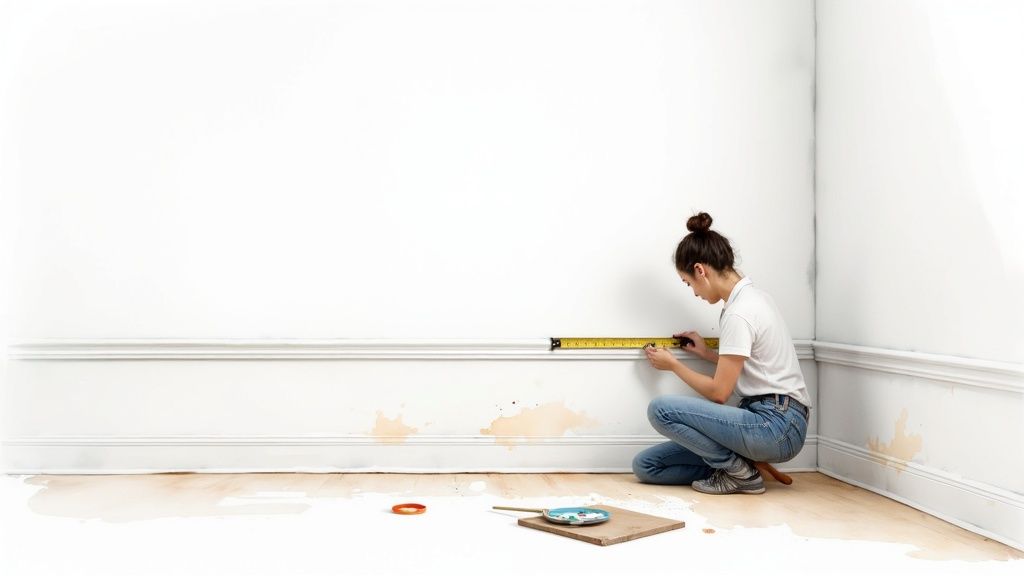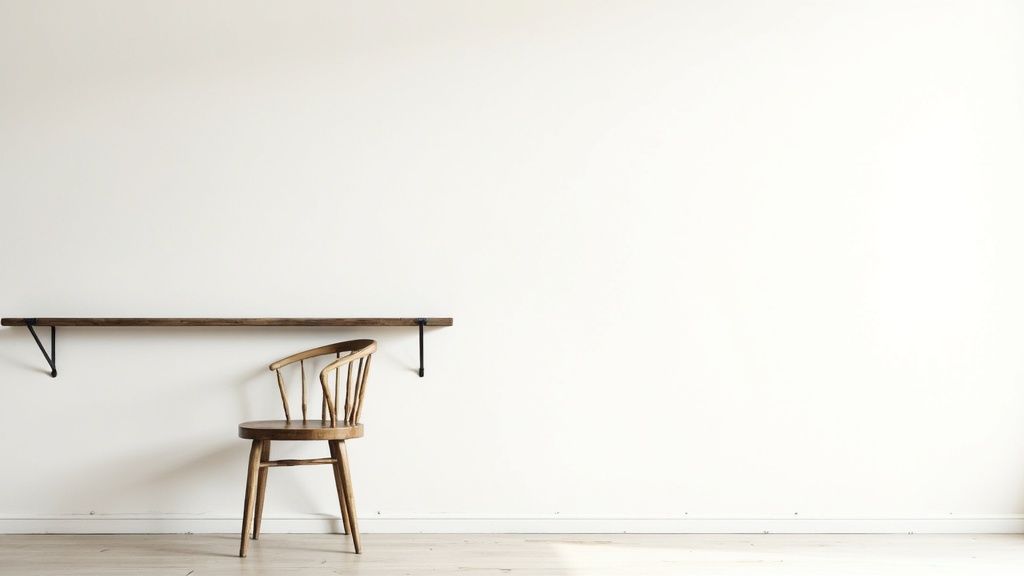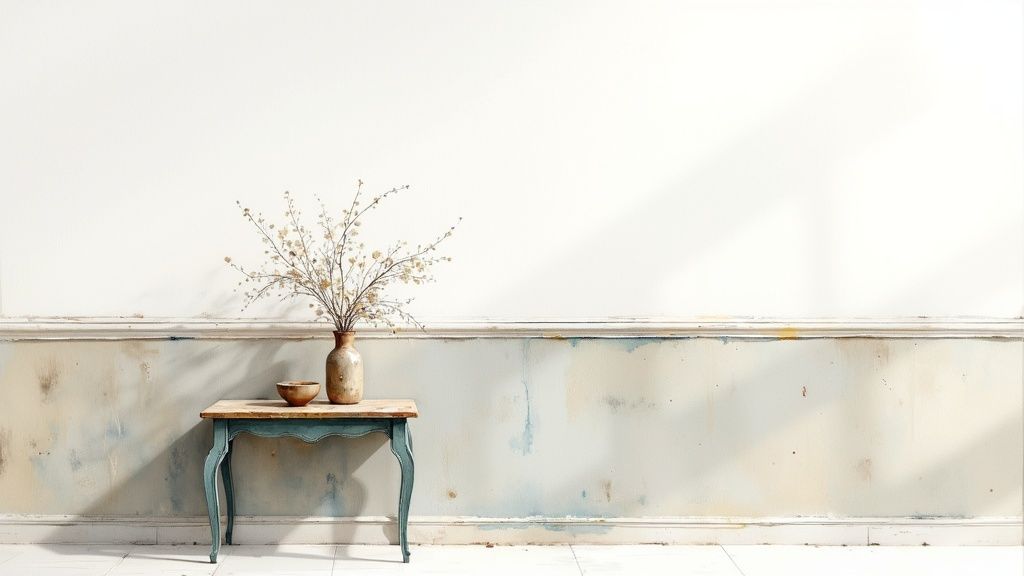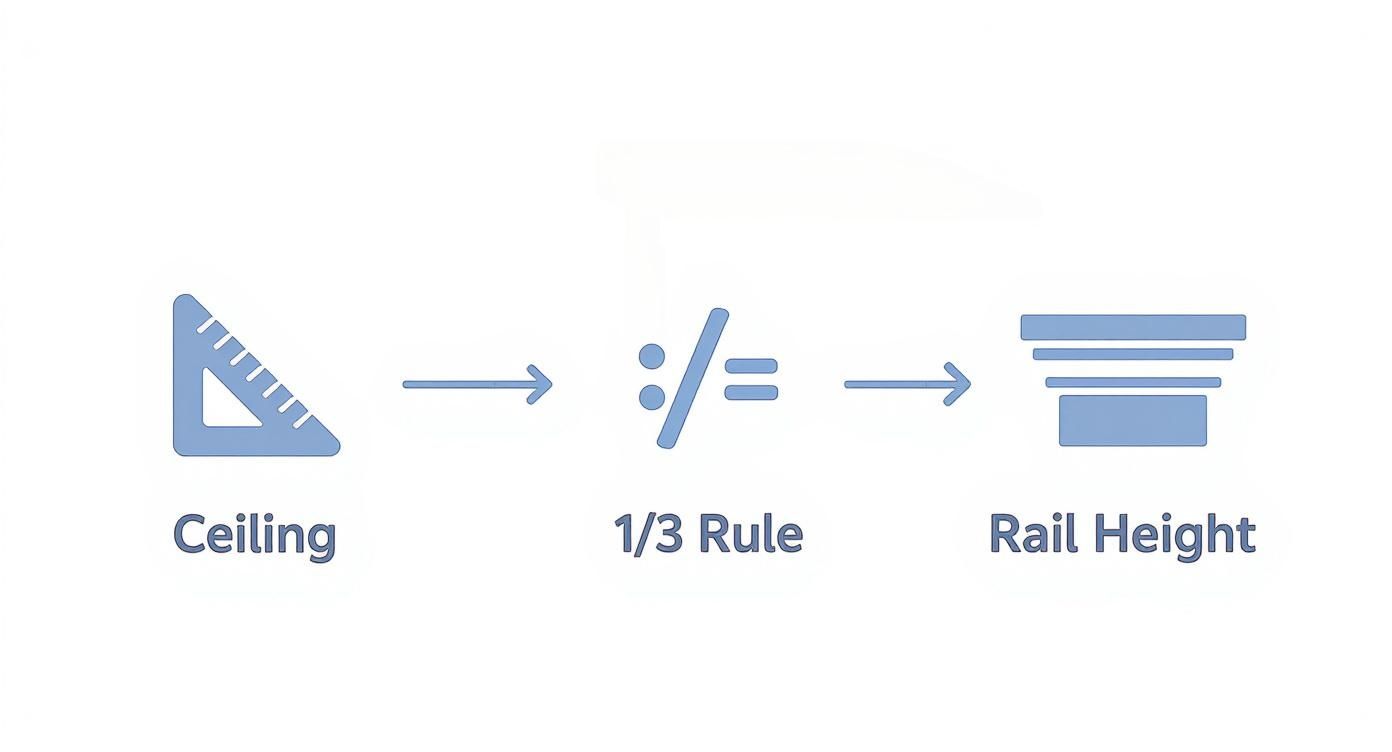What are chair rails and how to use them

Ever walked into a room and noticed a horizontal strip of molding running along the walls? That’s a chair rail. In its simplest form, a chair rail is a piece of molding that typically sits about a third of the way up from the floor. Think of it like a belt for your walls—it breaks up the space, adds a touch of architectural flair, and, as we’ll see, serves a very practical purpose.
What’s the Point of a Chair Rail, Anyway?

So, what do these things actually do? While today they’re largely seen as a decorative choice, their origins are purely functional. They were invented to stop the backs of chairs—especially heavy dining chairs—from scraping and denting delicate plaster walls.
Now, they do double duty.
Where Function and Style Collide
A chair rail is a classic example of when practicality becomes beautiful. It adds a ton of visual interest by splitting the wall into an upper and lower section, which opens up all sorts of design possibilities. You can play with two-tone paint schemes, add wallpaper below the rail, or use it to frame out wainscoting. This division helps ground a room and gives it a sense of proportion.
A well-placed chair rail does more than just protect your walls; it adds a layer of depth and character that can elevate an entire space from ordinary to exceptional.
Beyond just looking good, they’re still a smart, practical investment. The global market for chair rails was valued at around $1.2 billion and is expected to grow to $2.1 billion by 2033. This growth shows just how much homeowners and builders continue to value this feature. To see how these classic elements are being reimagined, it’s worth checking out the top home design trends that are shaping modern interiors.
For a quick reference, here’s a simple breakdown of what defines a chair rail.
Chair Rail Quick Facts
| Attribute | Description |
|---|---|
| Definition | A horizontal molding installed partway up a wall. |
| Primary Purpose | Originally to protect walls from chair damage; now also decorative. |
| Common Height | Typically installed 32 to 36 inches from the floor. |
| Material | Often made of wood, but also available in MDF, vinyl, or plaster. |
| Design Use | Divides walls for two-tone paint, wallpaper, or wainscoting. |
This table sums up the core identity of a chair rail—a simple feature with a surprisingly rich history and a lot of design potential.
Here’s the rewritten section, designed to sound like it was written by an experienced human expert.
More Than Just a Pretty Accent: A Story of Wall Protection
To really get what a chair rail is all about, you have to picture a time before they were a stylish choice. They weren’t invented for looks; they were born out of pure necessity. Think about the grand dining rooms of the 18th and early 19th centuries, filled with heavy, ornately carved wooden chairs.
Back then, it was common practice to push chairs away from the table, often with some force. Without something to stop them, the tops of those chairs would slam right into the delicate plaster walls, leaving behind a trail of scuffs, dents, and scrapes. This became a real headache, especially as expensive hand-painted wallpapers and fancy plasterwork became the fashion.
The fix was ingeniously simple: a strip of wood running horizontally along the wall, placed at the precise height to catch the back of a chair. This molding served as a bumper, taking the hit and saving the wall from constant damage.
From Function to Fashion
This practical feature, originally called a “dado rail,” became a standard in Georgian and Victorian homes. It was a purely functional invention meant to keep a room’s walls looking pristine. The term “dado” actually refers to the lower part of the wall, and this rail marked its upper edge.
The chair rail’s journey from a humble wall protector to a celebrated architectural feature highlights a core principle of classic design: practical solutions often evolve into timeless style.
But as tastes changed, so did the chair rail. What started as a simple, functional piece of wood slowly morphed into a major decorative player. Architects and designers realized they could use it to break up a tall wall, introduce a second paint color, or just add a touch of sophisticated detail. Its practical purpose never truly disappeared, but its aesthetic potential took center stage, securing its place as a classic design element we still love today.
How Chair Rails Can Transform Your Room Today

While they started out as a purely practical feature, chair rails have grown into a surprisingly versatile design tool. Today, they’ve got a dual identity: they’re part wall protector, part aesthetic powerhouse. And in busy parts of the house, that original protective function is as useful as ever.
Just think about a bustling hallway, a dining room where chairs are always moving, or even a kids’ playroom. In these high-traffic zones, a simple chair rail acts as a buffer, taking the hits from furniture, toys, and vacuum cleaners. It saves your drywall from constant dings and scrapes, meaning fewer touch-ups and repairs for you.
But let’s be honest, the real fun is in how they look.
A Shortcut to Architectural Character
Have a plain, boxy room that feels a little soulless? A chair rail is one of the quickest ways to add instant architectural interest. It breaks up those tall, blank walls, giving the room a sense of scale and purpose that makes it feel instantly more polished and intentional.
This simple horizontal line can completely change a room’s vibe by:
- Creating a visual divide: This opens up a world of possibilities for paint. Try a darker, more dramatic color below the rail and a lighter shade above to make the ceiling feel higher.
- Inviting in new textures: You’re no longer limited to just one wall treatment. You could paint the lower section and hang a beautiful wallpaper above it, adding layers of depth and personality.
- Framing other details: A chair rail is the perfect finishing touch for wainscoting or beadboard, giving the whole installation a clean, professional look.
A chair rail is like a visual anchor. It grounds the room’s entire design and gives you a built-in framework for getting creative with color, texture, and other millwork.
This classic feature is a key player in many traditional design styles. For example, if you look at Colonial Revival interior design, you’ll see how these moldings are crucial for creating that specific atmosphere of structured elegance. You can learn more about that style here: https://www.room-genius.com/blog/colonial-revival-interior-design/
In the end, whether you need a practical shield for your walls or just a subtle touch of class, the modern chair rail delivers. It’s proof that some design elements are timeless for a reason—they just work, bridging the gap between function and style to elevate any space.
Finding the Perfect Height for Your Chair Rail
Figuring out where to place a chair rail is one of those details that can make or break a room’s design. It’s less about the actual chairs and more about creating a sense of balance and proportion.
One of the biggest mistakes I see is when people simply measure the back of a dining chair and install the molding right there. It sounds practical, but it almost always results in a rail that looks uncomfortably low and throws the entire room’s proportions out of whack.
The Rule of Thirds: A Designer’s Secret
So, what’s the secret? Interior designers rely on a classic principle called the rule of thirds. The idea is to place the chair rail about one-third of the way up the wall, measured from the floor. This creates a visual anchor that feels natural, grounded, and intentional.
Calculating it is a breeze. Just take your total ceiling height in inches and divide it by three. For a standard 8-foot (96-inch) ceiling, this puts your ideal chair rail height right around 32 inches from the floor. It’s a simple bit of math that ensures your molding works with the room’s architecture, not against it.
Chair Rail Height Guide by Ceiling Height
To save you from pulling out the calculator, here’s a quick reference for the most common ceiling heights. It’s the perfect starting point for planning your project.
| Ceiling Height | Recommended Chair Rail Height (from floor) |
|---|---|
| 8 Feet (96 inches) | 32 inches |
| 9 Feet (108 inches) | 36 inches |
| 10 Feet (120 inches) | 40 inches |
Think of these numbers as a solid guideline, not an iron-clad rule. The ultimate goal is to create visual harmony, which is a fundamental part of good design. You can dive deeper into this concept in our guide on what is space planning.
When to Break the Rules
Of course, every room is different, and sometimes you need to adjust. The rule of thirds is a fantastic starting point, but always let your room’s existing features have the final say.
For example, look at your windows. If you have prominent window sills, it often looks best to align the top of your chair rail with the bottom of the sill. This creates a seamless horizontal line that feels cohesive.
Likewise, if you’re installing wainscoting, the chair rail will act as the top border, so its height will be determined by the panels below. The key is to step back, look at the room as a whole, and let its unique architecture guide you to the perfect placement.
Choosing the Right Style and Material
Once you’ve nailed down the “why” and “where” of your chair rail, the fun part begins: choosing a style and material that feels right for your home. Think of it like picking the perfect belt for an outfit—it needs to complement the whole look, not fight against it. The sheer variety available today means there’s a perfect match out there for every taste.
Your home’s existing architecture is your best guide. If your space is modern or minimalist, a simple, flat-profile molding will add a clean, subtle line. But for more traditional homes, like a Colonial or Victorian, you’ll want something with a bit more flair—a more ornate, detailed profile that echoes the home’s historic character.
Matching Materials to Your Needs
The material you pick affects not just the final look but also how well your chair rail holds up over time. Every option has its own pros and cons, so it’s smart to think about the room’s function before you commit.
- Solid Wood: This is the classic, go-to choice. You get authentic wood grain and crisp, beautiful details. It’s incredibly durable and can be stained or painted, but it’s usually the priciest option.
- MDF (Medium-Density Fiberboard): A great budget-friendly alternative that comes with a perfectly smooth surface, ready for paint. The downside? It doesn’t play well with water, so keep it out of bathrooms or damp areas.
- Polyurethane: A modern marvel. This synthetic material is lightweight, tough, and completely resistant to moisture, rot, and insects. It comes in a dizzying array of styles and is often much easier to install than real wood.
The real secret is finding the sweet spot between looks and practicality. That gorgeous solid wood rail might be a showstopper in a formal dining room, while a tough polyurethane option makes way more sense for a chaotic hallway where it will take some hits.
This visual breakdown really helps clarify how the ‘rule of thirds’ plays with your ceiling height to find that perfect installation spot.

It’s a great reminder that the rail’s height is all about the room’s unique proportions, not just lining up with the back of a chair.
The demand for this kind of architectural detail is huge. In a single year, there were over 600 shipments of chair rails imported globally from more than 250 different suppliers, which shows just how popular they’ve become. You can dig into more of this data over at Volza.com.
At the end of the day, the right chair rail should feel like it belongs, blending effortlessly with your baseboards, window trim, and color choices. For a little help on that front, take a look at our guide on how to choose color schemes for your space. When you put a little thought into both style and material, you’ll find a chair rail that truly elevates the room.
Common Questions About Chair Rails
Even after you’ve got a solid plan, a few questions always seem to pop up right when you’re ready to get started. Let’s tackle some of the most common ones, because getting these details right is what separates a good result from a great one.
First up, people often wonder if a chair rail and wainscoting are the same thing. The simplest way to think about it is that the chair rail is the cap, and the wainscoting is all the decorative paneling below it. You can absolutely have a chair rail on its own, but it’s also the perfect finishing touch for the top edge of wainscoting.
Then there’s the question of coordination. Should the chair rail match your baseboards and window frames? For a truly polished and intentional look, yes. Painting all the trim—baseboards, door casings, and your new chair rail—in the same color ties the room’s architecture together beautifully.
Navigating Tricky Spaces
What about rooms that aren’t perfectly standard? Say, your ceilings are lower than the typical eight feet. Can a chair rail still work without making the space feel squashed? You bet.
The trick in a room with low ceilings is to install the rail just a hair lower than the standard one-third mark. This subtle shift in placement fools the eye and can actually create the illusion of more height.
Pro Tip: If you want texture without a hard visual break, try painting the chair rail the same color as the wall beneath it. This creates a sophisticated, tone-on-tone effect that adds depth without chopping up the wall.
Another classic dilemma is how to handle a room with a chair rail that opens directly into one without it, like a dining room flowing into a hallway. There’s a clean and professional way to end the molding. A simple carpentry trick is to cut the end of the rail at a 45-degree angle back towards the wall. This is called a “return,” and it makes the molding look purposefully finished rather than just abruptly stopping.
Ready to see how a chair rail could look in your own home? With RoomGenius, you can stop guessing and start visualizing. Just upload a photo of your room, and our AI will generate incredible redesigns, showing you exactly how different molding and trim options will look. Start your free trial today at https://www.room-genius.com and discover the perfect style for your space.